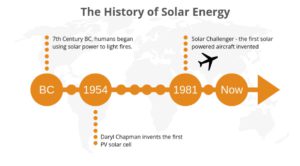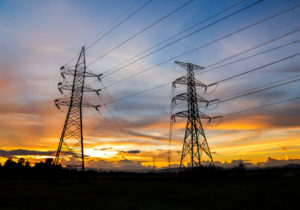
How the Use of Solar Energy by Humans Was Initiated
How many people today know about the origins and history of solar energy or solar panel development and first usage? Is the long and prevailing history of discoveries and events that led to modern photovoltaics (PV) generally known today or still a mystery to many individuals? By retracing the steps of history and „rewinding the ever-rolling footage” from the last centuries, we can learn about fascinating innovations in the evolution of solar energy and solar panels.
How Was Solar Energy Created and Who First Used Solar Energy on Planet Earth?
Since the very first vegetation and early animal life during the prehistoric stages of life on earth, the sun’s radiating solar energy has warmed and nurtured all forms of natural living and growing life. Since the transition from homos erectus to homo sapiens (the first humans) on the planet during the Middle Paleolithic Age (approximately 200,000 to 50,000 years ago), mankind in various stages of development and learning has grasped a basic realization of the sun’s power.
How did humans make the conceptual and practical journey from these early sun-related realizations through the many subsequent discoveries leading to current-day usage of solar energy to power huge factories, spacious homes, sprawling apartment complexes and large educational facilities? Through a long progression of observations, humans learned that sunlight could grow plants, warm the human body and light the earth until it disappeared behind clouds or fell below the horizon.
Earliest Conscious Harnessing and Use of Solar Energy
Energy from the sun was first put to use for a practical purpose around the 7th century B.C. when innovative humans began using direct sunlight to light fires with the aid of crude magnifying glasses. Later, during the 3rd century B.C., the Greeks and Romans focused solar energy using mirrors so that they could light flaming torches for use in religious processions and ceremonies. Similar burning mirrors were utilized by the Chinese around 20 A.D.
Where Was Solar Energy First Put to Ongoing Practical Use?
Early sun rooms were constructed to face south in Roman buildings that contained the famed Roman baths, places that answered the question of, „Where was solar energy first used?” With use of expansive windows, direct sunlight was gathered and directed into these rooms as early solarium designs for relaxation, contemplation and renewed health.
During the 1200’s A.D., predecessors of the Pueblo Native Americans (Anasazi) lived in modest home structures that looked southward from high mountainside cliffs to gain solar warmth during cold, blustery winters. This fact also answers queries of, „Where was solar energy first used?”
Later on, during the late 1700’s and early 1800’s, scientific researchers began powering ovens with light from the sun for use on lengthy trips by ship. They then learned to use solar energy as power for steamboats. These were early innovations in a long line of progressive steps in the use of harnessing solar power from the sun to fuel and operate many types of processes, mechanisms and equipment.
When Was the First Solar Panel Invented?
In the year 1839, Alexandre Edmond Becquerel, a 19-year old French physicist, discovered how electrical current can be produced from sunlight through the photovoltaic effect. As he explained, by focusing light on an electrode that is submerged in a solution with strong conductive properties, electricity can be generated. However, after this outstanding discovery and extensive research and experimentation that followed, photovoltaic power consistently produced inefficient levels of electric current.
Progressive Developments in the Use of Solar Panels for Energy Generation
Following this major discovery by Becquerel, a series of important revelations and inventions followed, leading the way toward the invention of the modern solar cell and further advancements in solar panel technology, including the following:
- 1873: Willoughby Smith determined that selenium offered photoconductive properties.
- 1876: William Grylls Adams and Richard Evans Day discovered that selenium generates electric current when it is exposed to direct sunlight.
- 1883: Charles Fritts created the first known solar cells from wafers of selenium. Fritts is usually given credit for inventing solar cells, although the first solar cell patent was not issued until 1941.
- 1954: Daryl Chapin, Calvin Fuller and Gerald Pearson produced the first silicon photovoltaic (PV) cell at Bell Labs. This important event in the development of solar technology supplied enough power to an electric device to operate for several hours. Although this silicon cell only had the capacity to convert sunlight at levels equal to four percent efficiency, it was considered by many scientists to be the true forerunner of the modern-day silicon solar cells.
Subsequently, solar cells were utilized primarily for light measurement for some time. Then, in 1941, more than 100 years after Becquerel’s discovery, Russell S. Ohl, an American engineer and semiconductor researcher patented the modern solar cell, not long after the transistor was invented. He determined that when photons (light) strike specific metal compounds, the metallic surfaces emit electrons. When light strikes other types of compounds, these surfaces accept electrons.
With the combined use of these two types of compounds, electrons can be caused to channel through a conductor to generate electricity. This is the photo-electric effect. The meaning of the photovoltaic (PV) process is sunlight conversion into a flowing current of electrons to create electricity.
Additional Events of Note in the Development of Solar Cell and Panel Technology
Now we are all more enlightened about the answer to the question, „How was solar energy created?” More important milestones and occurrences in the continuing advancements in solar cell and panel technology and use as the history of solar energy progressed include the following:
- Solar Panel Use in Space Exploration. – Solar panels were used to power satellites in global space exploration when that solar panel was invented, as early as 1958, when radios in the Vanguard I satellite were powered by one-watt panels. During that year, the Vanguard II, Explorer III and Sputnik-3 were launched on their journeys in outer space with use of PV technology. NASA launched the initial Nimbus spacecraft in 1964, powered by 470 watts of solar energy, and the first Astronomical Observatory in 1966, run by a one-kilowatt array.
- Earliest Solar Residence. – During 1973, the first solar building, „Solar One,” was built by the University of Delaware. Energy for this residence was supplied by hybrid sources of solar thermal and solar PV power as the first example of integrated photovoltaics (BIPV) used in a building. Its array used a rooftop integrated solar installation with solar panels, when that solar panel was invented, similar to the Tesla design. Two U.S. Presidents, Jimmy Carter and Barack Obama, had solar panels installed in the White House.
- Solar Conversion Efficiency Advancements. – From 1957 to 1960, Hoffman Electronics made frequent advancements in PV efficiency, raising efficiency rates from 8 percent to 14 percent. In 1985, the University of South Wales produced 20 percent efficiency levels in silicon cells. Later, in 1999, collaborative work of the National Renewable Energy Lab and SpectroLab Inc. resulted in a solar cell with 33.3 percent efficiency, and in 2016, the University of South Wales achieved 34.5 percent levels.
- Solar-Powered Aircraft. – In 1981, the earliest airplane built to operate on solar energy, „Solar Challenger,” was introduced by Paul MacCready, who piloted his plane across the English Channel. In 1998, „Pathfinder,” a remote-controlled solar aircraft, broke altitude records by reaching 80,000 feet. A NASA non-rocket aircraft later surpassed that record in 2001, reaching 96,000 feet. In 2016, Bertrand Piccard piloted „Solar Impulse 2,” the most powerful solar plane, around the world in the initial zero-emissions flight.
Energy Efficiency and Cost-Effectiveness of Modern Solar Panel Use
Solar panels are extremely practical and cost-effective for ongoing production of electric power. They are relatively simple to install and require very low degrees of maintenance. These panels are constructed without any modules or moving parts, which increases their dependability for long-term use. Solar panels produce electric current without any need for use of the earth’s valuable natural resources.
Modern solar panels can produce electricity with no resulting pollution or waste. They can be conveniently installed wherever they are needed to generate electric power. This eliminates the necessity of distributing electric current for long distance use in remote locations of the country or globe. Also, power production using solar photovoltaic methods can be accomplished on any scale without the constant need for large, costly facilities.
Conclusion
We think you will agree that the history of solar energy and its stages of development have been lengthy, complex and quite fascinating. The use of solar panels for providing power to homes, schools, public buildings and commercial offices and facilities of all types is now widespread globally. However, this has occurred only after many years of concentrated research, discoveries and experimentation by scientists and inventors.
Each success in the study and development of photovoltaic (PV) energy production and use led to subsequent studies, experiments and further advancements in this intriguing and important field of discovery. From Becquerel’s initial discovery in 1839 to today’s popular use of solar energy, every step toward harnessing the sun’s energy for highly productive, economical and eco-friendly use has been equally innovative and valuable to the earth and to humankind.
We welcome any ideas and comments that you may want to share on the topic of solar energy, its history, its use today and its potential for future advancements and use. The sun has actually powered and nurtured the earth ever since the first microbes were enabled to perform photosynthesis (synthesize foods from carbon dioxide and water), approximately 2.3 billion years ago. Do you think the sun will prevail in future years as the infinite energizer of Planet Earth? Please share your thoughts with us and other readers.
If you are considering installing solar panels to power your home, office or an entire commercial facility today, now is an excellent time to do so. The prices for solar panels and solar power use have plummeted due to popular use. In 1956, solar panel usage was priced at about $300 per watt. In 1975, the cost had dropped to around $100 per watt, and today, the cost of using a solar panel is approximately $0.50 per watt.
To begin enjoying the advantages of the sun’s natural power supply today, just take a few simple steps:
- Perform an online search for solar panel suppliers and installers in your location.
- If you’re in or near Stockton, San Joaquin County, Concord, Hayward or San Francisco Bay Area, give us a call for a fast and free quote.
- Schedule your solar panels installation, and start benefiting from healthy, eco-friendly, efficient and cost-effective solar power for your home or business today[1].
[1] https://www.sunpowerbythesolarquote.com/blog/history-of-solar-energy





